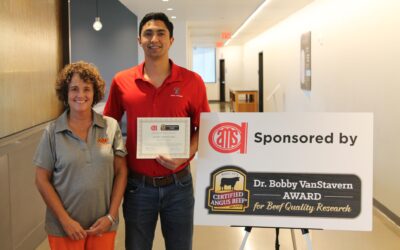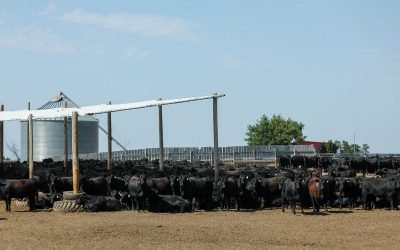
Don’t blame the calves
Yearling cattle don’t necessarily trump calf feds in the feedyard or packinghouse
by Laura Conaway
Things aren’t always what they seem.
It’s no secret, marbling in harvested fed cattle declines from late February to early May each year (See Chart). That coincides with a seasonal switch from yearlings to calf-feds in the harvest mix, which often gets the blame.
Yet, recent data from the University of Minnesota (UMN) suggests we should reconsider the blame game; or, at the very least ,not let it deter cattlemen from feeding calves a high-energy diet (calf-feds).
“It’s interesting that perception is out there, given there’s knowledge that calf-feds actually marble better,” says UMN animal scientist Alfredo DiCostanzo.
He and PhD graduate student Haley Johnson’s meta-analysis of 32 studies on the effects of pre-finishing strategy (backgrounding or stockering) on feedlot and carcass performance leaves little room for the long-held belief. Today’s economic conditions, beef genetics and value-based markets certainly favor a calf-fed approach.
Still, thanks to that seasonal pattern, “the opinion is engrained in our business,” says Paul Dykstra, beef cattle specialist for the Certified Angus Beef ® (CAB®) brand. He’s glad to see a summarizing study on calf-fed marbling, “because there’s no doubt they can do it.”
“This analysis matches that of our own feedlot partnership database at CAB,” he says, noting its reach across 2 million cattle records from 80 feedyards in 16 states.

DiCostanzo and Johnson’s data (See Table) shows cattle fed a high-energy diet in the backgrounding phase achieved higher average marbling scores than cattle backgrounded on winter wheat, those exposed to unlimited forage with a restricted ration, or grazing dormant grass prior to the finishing phase.
“Plenty of feedlot nutritionists agree with these findings because they’ve seen this for a long time themselves,” he says.
So why the contradiction between perceptions, trends and facts? CAB’s Justin Sexten sees answers in the questions.
“It’s a complex system, influenced by many factors,” the brand’s director of supply development says. “Historical data alone won’t show the complete picture, because today’s cattle genetics offer much greater potential than 10 or 20 years ago.”
Yearlings today can gain two pounds on a moderate level of energy. Calf-feds now reach finished weights once unimaginable.
DiCostanzo says his team’s research aimed to explain the mechanisms of backgrounding that enable marbling and permit heavier finished weights, regardless of seasonal trends.
Cattle will always sell on pounds, yet there will be added rewards for marbling.
Producers must ask, “What am I going to give up so I can get this other thing?” DiCostanzo suggests. “I think the correct mix is somewhere in the middle,” where a combination of weight and marbling achieve the greatest value, particularly when the Choice/Select spread is wide.
“If the spread is favorable, they may consider employing a little more energy into calves’ backgrounding diets or reducing the backgrounding period so that cattle don’t get so heavy,” making them susceptible to discounts.

There’s a long list of reasons why quality grade takes a hit each year. Young calves are more prone to sickness in the early stages of feeding and the first calf-feds harvested are often lighter. Weather and origins come into play, and there are wide differences in genetic potential.
DiCostanzo cites his South Dakota colleague Robbi Pritchard’s findings that, given at least average marbling ability and enough time, long feeding periods on forage need not derail that marbling potential. Good genetics provide more options, he suggests.
“You have the best of both worlds if you’re able to background to about 800 pounds (lb.), no more than that, and at that point turn them onto a high-finishing diet, harvesting at 1,400 lb. That should be able to give you both weight and marbling,” DiCostanzo says.
“It should motivate sellers of superior-marbling Angus cattle to consider the typically wider Choice/Select spread, Prime and CAB premiums featured in the spring as a margin-enhancing target,” Dykstra says.
Since both yearling and calf-fed programs can each work without sacrificing grade, most producers can find ways to reach their optimum target.
“We need to have this discussion to get past that first impression to try and have a more objective conclusion on this,” DiCostanzo says.
You may also like
Certified Angus Beef Recognizes Beef Quality Research
First-place honors go to Andres Mendizabal, an international student pursuing a Ph.D. in animal science at Texas Tech University. His research is titled, “The Accuracy of USDA Yield Grade and Beef Carcass Components as Predictors of Red Meat Yield.”
Not all good days are sunny and warm
Stress of any kind affects performance and health, but also well-being and behavior, a special focus for CSU animal scientist Lily Edwards-Callaway. Her team’s literature review found shade benefits vary by location, structure type and the weather.
Flavor’s secret ingredient
As a moderately to highly heritable trait, marbling is something that cattlemen have a lot of ability to manage. It also happens to be one of the major contributors to beef flavor. Texas Tech University meat scientist Jerrad Legako spoke about the topic at the 2020 American Society of Animal Science meetings.



